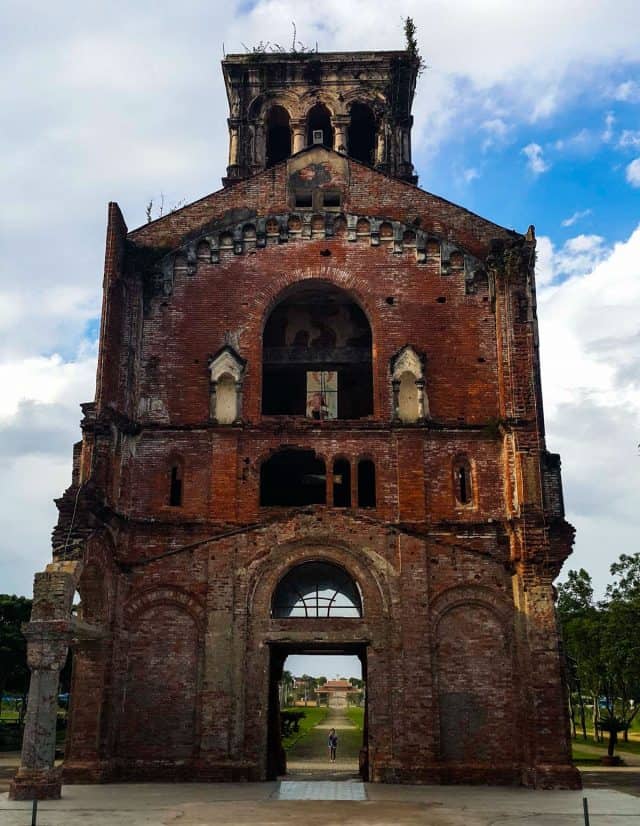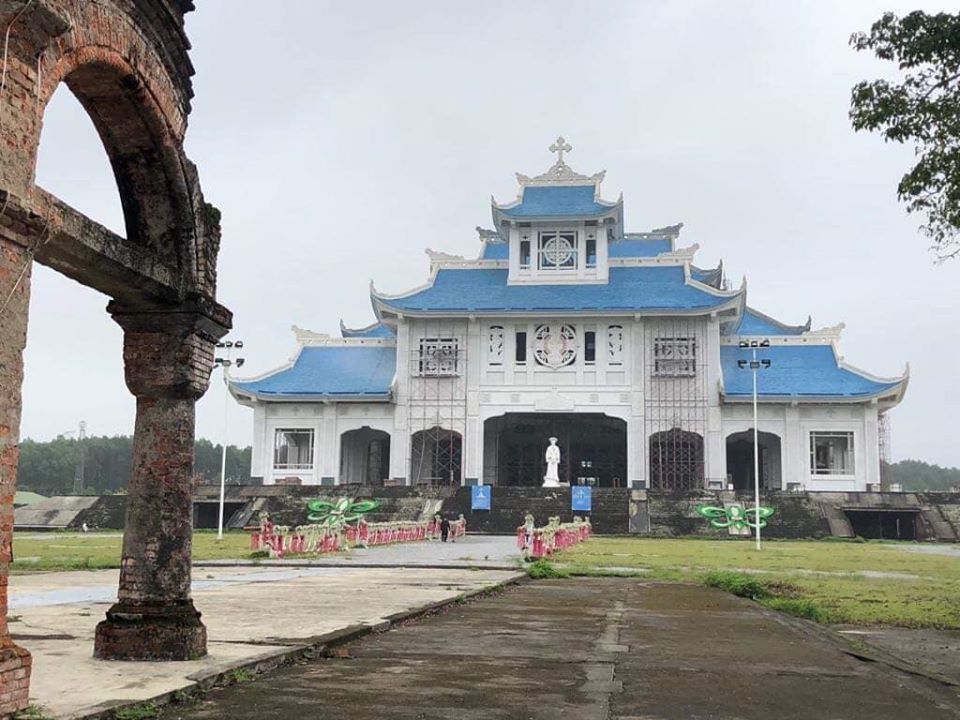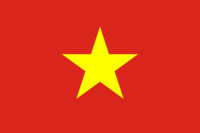La Vang Sanctuary – A Spiritual Destination in Quang Tri
La Vang Sanctuary has long been a renowned tourist attraction in Quang Tri. La Vang holds significance not only for the Catholic community but also for non-Catholics and international tourists alike. Explore this article from Vntrip.vn to learn about the La Vang Sanctuary and the legend of the Apparition of the Blessed Virgin Mary.
See more: Vinh Moc tunnel
Where is La Vang Sanctuary?
La Vang Sanctuary is located in the area formerly known as Dinh Cat (in the 16th century, during the reign of Lord Nguyen Hoang, this region was referred to as Dinh Cat, which translates to “Catholic Palace” or “Sandy Palace”). Today, it belongs to Hai Phu Commune in Hai Lang District, Quang Tri Province. It is situated approximately 6 kilometers south of Quang Tri Ancient Citadel and 60 kilometers north of Hue City. La Vang Sanctuary is the national center for Our Lady in the Catholic Church in Vietnam.
Traveling to La Vang from Hanoi, Ho Chi Minh City, or other locations is relatively straightforward. There are various methods of transportation available, including trains, North-South buses, and motorcycles.
If you choose to travel by bus along National Highway 1A (QL 1A), you can reach Quang Tri Town in Quang Tri Province. Disembark at Cau Trang, and then take a motorbike taxi or a regular taxi to La Vang Sanctuary, which is approximately 4 kilometers away.
For those taking the train, you can get off at Dong Ha Station and then take a motorbike taxi or taxi to La Vang Sanctuary, which is approximately 16 kilometers away. Alternatively, you can disembark at Hue Station, which is 57 kilometers from La Vang. If you stop in Hue, you can rent a tourist vehicle to visit the Imperial City of Hue first and then make your pilgrimage to La Vang.
If you prefer traveling by motorcycle, in Hai Phu Commune, there are two diverging roads about 5 kilometers apart. One has a sign that reads “La Vang 4km,” and the other has a sign that reads “Thánh địa La Vang 2km.” Both roads are relatively wide and lead pilgrims to the sanctuary.

Origin of the Name “La Vang”
There are two theories regarding the origin of the name “La Vang.” The first theory suggests that “La Vang” represents the cry for help when people encountered wild animals. Those who ventured into the forest would use the term “La Vang” to alert others in case of danger. Alternatively, it could refer to the loud voices of the local Catholic population when they needed to communicate over long distances in the densely wooded area.
The second theory traces the name back to “lá vằng,” which translates to “vằng leaves.” According to this theory, when the Catholic community sought refuge in this region during a time of illness, the Blessed Virgin Mary appeared to them and instructed them to find and brew a type of leaves known as “lá vằng” to treat their ailments. “Lá vằng” is believed to have significant health benefits, and many people harvest or purchase these leaves for consumption.
The Legend of the Apparition of the Blessed Virgin Mary
La Vang Sanctuary is a place filled with the love and grace of the Blessed Virgin Mary, who appeared to the faithful in 1798 during the reign of King Canh Thinh, the son of King Quang Trung.
According to historical documents from the Archdiocese of Hue in 1998, under King Canh Thinh’s reign (ascended the throne in 1792), an edict was issued on August 17, 1798, banning Catholicism. As a result, some believers in the region near Dinh Cat (now Quang Tri Town) sought refuge in the forested hills of La Vang. The conditions were harsh: there was limited food, illness spread, and the faithful lived in fear of both the military and wild animals. However, they maintained their unwavering faith in God and the Blessed Virgin Mary. They often gathered under the branches of a giant banyan tree to pray, console one another, and help those in need.
One day, while the people were reciting the rosary, they witnessed a beautiful woman dressed in a long robe, carrying an infant in her arms, with two angels holding lamps on either side. They recognized her as the Virgin Mary. The Blessed Mother showed compassion, comforted them, and provided guidance. She instructed them to collect leaves from the surrounding trees, brew them into a medicinal drink to cure their illnesses, and assured them, saying, “I have received your petitions. From now on, whenever anyone comes here to implore me, I will accept their prayers and grant them grace.”
The Apparition of the Blessed Virgin Mary occurred in La Vang near the ancient banyan tree where the faithful were praying. Many who were present witnessed this miracle. Subsequently, the Blessed Mother appeared several more times to support and console her children during a century of persecution and hardship due to their faith. It was through her promise of grace that La Vang became a place of pilgrimage for countless individuals seeking blessings and honoring the Blessed Mother.
What to See at La Vang Sanctuary
La Vang Sanctuary, also known as “Tiểu vương cung thánh đường La Vang” (Small Royal Sanctuary of La Vang), has endured the test of time and historical events. Today, it radiates its timeless beauty in the midst of Hai Lang, Quang Tri. The architecture of the church adheres to the traditional style of Catholic churches.
However, the moss-covered church exterior adds a unique charm, making it reminiscent of historical periods and events. The greenery surrounding the church enhances its distinctiveness, evoking a sense of the past beyond the confines of this sacred place.
In the center of the sanctuary grounds, you can still find the bell tower of the Royal Sanctuary of the Virgin Mary at La Vang. This structure was constructed from 1924 to 1929 and underwent significant renovations in 1959. During the summer of 1972, the bell tower suffered damage due to the war.
At the location believed to be where the Blessed Virgin Mary appeared near the ancient banyan tree, an impressive monument has been erected. This monument depicts three banyan trees with the Blessed Virgin Mary in the center. Statues of the Blessed Virgin Mary La Vang can also be found in various places within the sanctuary. The image typically portrays her as a woman wearing traditional Vietnamese ao dai attire, holding an infant similarly dressed.
In front of the bell tower of the Royal Sanctuary, there is a spacious square. On either side of the square, you can find the Stations of the Cross, consisting of 14 sculptures illustrating the stages of Jesus’ suffering, from his condemnation to his crucifixion and burial.
Within the sanctuary grounds, there is a well known as “Giếng nước Đức Mẹ La Vang” (The Well of the Blessed Virgin Mary at La Vang). Pilgrims who visit La Vang often drink water from this well as a sign of reverence to the Blessed Mother. Many believe that the well’s water possesses healing properties.

La Vang Pilgrimage Festival
The La Vang Pilgrimage Festival takes place every three years at La Vang Sanctuary. The most recent festival, the 31st, occurred over three days from August 13 to August 15, 2017. Historically, the pilgrimage festival dates back to 1901, with variations in its schedule throughout the years, but it typically falls in August.
Starting from the 23rd festival in 1993, the La Vang Pilgrimage Festival has been held every three years on August 13, 14, and 15. It attracts the participation of numerous bishops, priests, nuns, and hundreds of thousands of Catholic faithful from within and outside of Vietnam.
During the three-day festival, various activities take place. There are discussions on specific topics, prayer vigils, and the grand procession of the Blessed Virgin Mary, which is a significant and solemn ceremony attended by a multitude of the faithful. The procession is a distinctive ritual that honors the Blessed Virgin Mary during the festival.
One of the highlights is an elaborate night prayer session that is meticulously prepared and a Holy Eucharistic Adoration night beside the Blessed Mother. The most solemn Mass of the festival is the Feast of the Assumption of the Blessed Virgin Mary, celebrated on the morning of August 15, which also marks the conclusion of the festival

